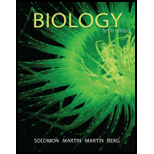
Concept explainers
Introduction: Plants are non-motile living beings that are capable of producing their own food by utilizing the sunlight, carbon dioxide, and water. They form the kingdom Plantae that includes all the plants such as trees, shrubs,
Answer to Problem 1TYU
Correct answer: Most of the plant body consists of the ground tissue system.
Hence, the correct answer is option (a).
Explanation of Solution
Reason for the correct answer:
The majority of the plant body consists of the ground tissue system because it is an essential portion of plants to supply mineral nutrients and water to the organisms. The ground tissue system includes parenchyma, collenchyma, and sclerenchyma which provide a variety of functions such as photosynthesis, storage, and support.
Option (a) is given as “ground”.
Most of the plant body includes ground tissue system as it is a necessary portion of plants to supply mineral nutrients and water to the organisms.
Hence, the correct answer is option (a).
Reasons for the incorrect answers:
Option (b) is given as “vascular”.
Vascular tissue system involves the vascular plants consist of two specialized tissues called the xylem and phloem those act as a conducting tube in plants for the transportation of water and sugar molecules throughout the plant. Most of the plant body does not consist of vascular tissue system.
Hence, option (b) is incorrect.
Option (c) is given as “periderm”.
Periderm is the type of dermal tissue found in the plant cell. In plants, there are only three tissue systems that include vascular tissue, ground tissue, and dermal tissue. Thus, periderm is not a tissue system.
Hence, option (c) is incorrect.
Option (d) is given as “dermal”.
The cell of dermal tissue that protects the soft tissue of plants also helps to control interactions with the plants and its surroundings and this is called dermal tissue system. Most of the plant body does not consist of dermal tissue system.
Hence, option (d) is incorrect.
Option (e) is given as “cortex”.
The outermost layer of root or stem of a plant is called cortex. In plants, there are only three tissue systems that include vascular tissue, ground tissue, and dermal tissue. Thus, cortex is not a tissue system.
Hence, option (e) is incorrect.
Hence, options (b), (c), (d), and (e) are incorrect.
Ground tissue system includes the tissues with only one cell type like the parenchyma, collenchyma, and sclerenchyma.
Want to see more full solutions like this?
Chapter 33 Solutions
Biology (MindTap Course List)
- What is the result of the following gram stain: positive ○ capsulated ○ acid-fast ○ negativearrow_forwardWhat type of stain is the image below: capsule stain endospore stain gram stain negative stain ASM MicrobeLibrary.org Keplingerarrow_forwardWhat is the result of the acid-fast stain below: Stock Images by Getty Images by Getty Images by Getty Images by Getty Image Getty Images St Soy Getty Images by Getty Images by Getty Images Joy Getty encapsulated O endosporulating negative ○ positivearrow_forward
- You have a stock vial of diligence 75mg in 3ml and need to draw up a dose of 50mg for your patient.how many mls should you draw up to give this dosearrow_forwardYou are recquired to administer 150mg hydrocortisone intravenously,how many mls should you give?(stock =hydrocortisone 100mg in 2mls)arrow_forwardIf someone was working with a 50 MBq F-18 source, what would be the internal and external dose consequences?arrow_forward
- We will be starting a group project next week where you and your group will research and ultimately present on a current research article related to the biology of a pathogen that infects humans. The article could be about the pathogen itself, the disease process related to the pathogen, the immune response to the pathogen, vaccines or treatments that affect the pathogen, or other biology-related study about the pathogen. I recommend that you choose a pathogen that is currently interesting to researchers, so that you will be able to find plenty of articles about it. Avoid choosing a historical disease that no longer circulates. List 3 possible pathogens or diseases that you might want to do for your group project.arrow_forwardnot use ai pleasearrow_forwardDNK dagi nukleotidlar va undan sintezlangan oqsildagi peptid boglar farqi 901 taga teng bo'lib undagi A jami H boglardan 6,5 marta kam bo'lsa DNK dagi jami H bog‘lar sonini topingarrow_forward
- One of the ways for a cell to generate ATP is through the oxidative phosphorylation. In oxidative phosphorylation 3 ATP are produced from every one NADH molecule. In respiration, every glucose molecule produces 10 NADH molecules. If a cell is growing on 5 glucose molecules, how much ATP can be produced using oxidative phosphorylation/aerobic respiration?arrow_forwardIf a cell is growing on 5 glucose molecules, how much ATP can be produced using oxidative phosphorylation/aerobic respiration?arrow_forwardHow do i know which way the arrows go?arrow_forward
 Biology (MindTap Course List)BiologyISBN:9781337392938Author:Eldra Solomon, Charles Martin, Diana W. Martin, Linda R. BergPublisher:Cengage Learning
Biology (MindTap Course List)BiologyISBN:9781337392938Author:Eldra Solomon, Charles Martin, Diana W. Martin, Linda R. BergPublisher:Cengage Learning
 Biology 2eBiologyISBN:9781947172517Author:Matthew Douglas, Jung Choi, Mary Ann ClarkPublisher:OpenStax
Biology 2eBiologyISBN:9781947172517Author:Matthew Douglas, Jung Choi, Mary Ann ClarkPublisher:OpenStax Biology: The Unity and Diversity of Life (MindTap...BiologyISBN:9781305073951Author:Cecie Starr, Ralph Taggart, Christine Evers, Lisa StarrPublisher:Cengage Learning
Biology: The Unity and Diversity of Life (MindTap...BiologyISBN:9781305073951Author:Cecie Starr, Ralph Taggart, Christine Evers, Lisa StarrPublisher:Cengage Learning Biology: The Dynamic Science (MindTap Course List)BiologyISBN:9781305389892Author:Peter J. Russell, Paul E. Hertz, Beverly McMillanPublisher:Cengage Learning
Biology: The Dynamic Science (MindTap Course List)BiologyISBN:9781305389892Author:Peter J. Russell, Paul E. Hertz, Beverly McMillanPublisher:Cengage Learning Biology Today and Tomorrow without Physiology (Mi...BiologyISBN:9781305117396Author:Cecie Starr, Christine Evers, Lisa StarrPublisher:Cengage Learning
Biology Today and Tomorrow without Physiology (Mi...BiologyISBN:9781305117396Author:Cecie Starr, Christine Evers, Lisa StarrPublisher:Cengage Learning





